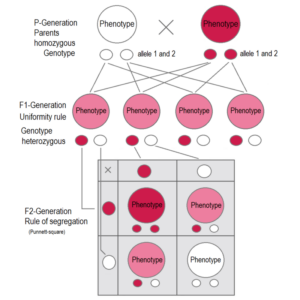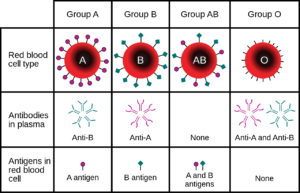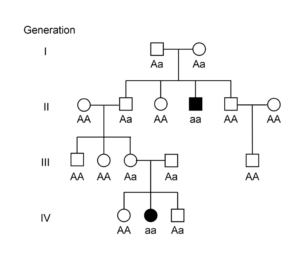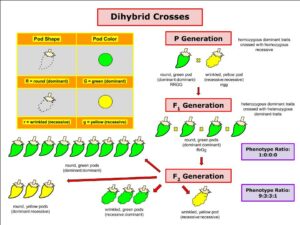Genotype refers to the collection of genes present in any individual organism. In all organisms formed by miscegenation, in a single chromosome pair, one strand comes from the mother and one from the father.
In such cases, genes in an organism are a mix coming from both parents, so they carry features from both parents. In organisms produced via cloning or apomixis, the genetic constituent is the same as that of the parent.
Some features showing the genotypic ratio examples include:
- Eye colour
- Height
- Flower colour
- Seed shape
- Hair colour
- Pollen shape
- Lactose Intolerance
- Sickle cell Anaemia
- Blood grouping
- Erythroblastosis fetalis
Next we will discuss the above mentioned genotypic ratio examples in detail:
Eye colour:
The gene coding eye colour is a specific allele. The brown colour is the most common eye colour represented by B. All other uncommon colours are represented by “b” including- blue or green. In most cases, the genotype having homozygous dominant (BB) or heterozygous (Bb) have brown or a slightly flecked eye colour. Individuals having green or blue eye colour are born with the homozygous recessive gene from both parents with genotype “bb”.
The genotypic ratio is 1:2:1
Flower colour:
If a plant has two main colours Red which is the dominant colour represented by the genotype of “RR” while white is the recessive colour type with genotype “rr”. In the first gen, only pink flowers are obtained with genotype “Rr” because the while colour gene cannot be fully suppressed by the dominant red colour. In the second generation, there is a 25% chance of the flower being completely red and another 25% chance that the flower will be completely white. The rest 50% of the flowers will be hybrids i.e. they will be varying shades of pink.

Image: Wikipedia
Height:
Height is also a monotypic gene allele represented by “T”. In plants like in pea the standard dominant height is 1m on average represented by the genotype TT. Dwarf plants with genotype “tt” can only reach up to a height of 25cm. Hybrid tall trees can be as tall as the dominant genotypes, because of the dominance of the tall gene.
In humans as well an individual can be born with the same TT, Tt or tt genotype. The height is measured by the average of the two alleles in every respective case. This is the reason that unlike plants humans vary so drastically in height.
Hair colour:
Hair colour is another partially dominant gene. Hence the 50% who have a hybrid genotype have a mixed hair colour derived from both parents.
Seed shape:
The outer seed cover can be round or wrinkled in plants like a pea. The gene that is responsible for this feature is completely dominant. The phenotype ratio is 3:1 while the genotypic ratio is 1:2:1. So RR and Rr both genotypes produce round seeds whereas rr produces wrinkled seeds
Pollen shape:
Pollen shape is another genotypic feature that is not completely dominant. The dominant shape is elongated, while the recessive shape is rounded or small. In hybrid cases, the size of the pollen is somewhere in between.
Lactose Intolerance:
Lactose intolerance is caused due to the mutation in the lactogen producing genes, which affects the production of the enzyme lactase which digests or breaks down lactose. People with this malady cannot digest dairy or dairy products.
Lactose intolerance in infants is inherited and like most gene-related disorder is autosomal recessive i.e. it only occurs when both the genes have the recessive allele coming from both parents. So a child born to parents who are both are carriers of the gene has a 25% chance of being born lactose intolerant.
Blood Grouping:
Blood grouping is one of the most complex genotypic examples. Now ABO grouping without the rhesus factor consists of 4 blood groups- A, B, AB and O. Like the group suggests there are only 3 types of alleles- one producing A antigen, one producing B antigen and one producing neither “o”. A combination of these 3 make up the 3 groups
- A group- AA/ Ao
- B group- BB/ Bo
- AB group- AB
- O group- oo

Image: Wikipedia
So the reason why a child born to parents having blood groups A and B can be born A, B, AB or O depending on the genotype of the parent and the genotypic combination of the child.
Sickle Cell Anaemia:
Sickle cell anaemia is another autosomal recessive disorder. Cause due to mutation in a single N base casing a change in the constituent amino acid translated from the codon. This causes the normal biconvex shape of haemoglobin to become deformed in a C shaped sickle form, that is prone to disintegration.

The reason why males are prone to this SCA is that this affliction considers the Y chromosome as a recessive gene. Hence even when they were supposed to be simply carriers they can become affected by the affliction.
Erythroblastosis fetalis:
Erythroblastosis fetalis refers to jaundice that occurs in unborn infants who are born to Rh -ve mothers but itself is Rh+ve.
The Rh factor is simply inherited from any parent means it has not been passed on from either parent. So for the Rh factor actually the genotype is the same 1: 2: 1. So the child can be positive with both genes having Rh factor or one gen not having it. Only when both genes are devoid of the Rh factor is the offspring Rh -ve
What is the genotypic ratio of the offspring?
The genotypic ratio of the offspring depends on the genotype of the parent themselves.
Parents can be purely homogenous or hybrid. Crossing homogenous and hybrid parents amongst themselves or with each other can produce different genotypic ratios among the offspring.
Let us consider the genes for height as T and t where they represent the dominant and recessive genes respectively. So TT is homogenous tall, tt is a homogenous dwarf and Tt is hybrid.
Crossing both tall or short parents: TT X TT or tt
| Zygote | T | T |
| T | TT | TT |
| T | TT | TT |
In such a situation all offspring would be short or tall or dwarf and the genotypic ratio would be 1
Crossing two hybrid parents: Tt X Tt
| Zygote | T | t |
| T | TT | Tt |
| t | Tt | tt |
In this case there the genotypic ratio is tall: hybrid: dwarf is =1:2:1
Crossing a hybrid with a homogenous parent: TT X Tt and Tt X tt
| T | T | |
| T | TT | TT |
| t | Tt | Tt |
| T | t | |
| t | Tt | tt |
| t | Tt | tt |
In both cases, the genotypic ratio of Homogenous to hybrid is = 1: 1
The genotypic ratio of dihybrid cross:
A dihybrid cross refers to when 2 different genes with their respective dominant and recessive alleles. Normally for a dihybrid cross, the alleles must be close to one another and not interfere with the inheritance of the other.
The main cross is performed when taking in both heterozygous parents. To demonstrate we will use the Flower colour and Flower position
| Feature | Dominant | Recessive |
| Colour | Violet (WW) | White (ww) |
| Position | Axial (AA) | Terminal (aa) |
So a homogenous dominant parent has the genotype “WWAA” while a homogenous recessive parent has genotype “wwaa”. In the first generation after crossing both homogenous parents only one type of hybrid is obtained with genotype “WwAa”.
In the second generation on crossing two hybrids, the zygotes have 4 different genetic constitutions- WA, Wa, wA, wa. With these, we will make a punnet square.
| F2 | WA | Wa | wA | wa |
| WA | WWAA | WWAa | WwAA | WwAa |
| Wa | WWAa | WWaa | WwAa | Wwaa |
| wA | WwAA | WwAa | wwAA | wwAa |
| wa | WWAa | Wwaa | wwAa | wwaa |
The dihybrid cross has a complex genotypic ratio consisting of 9 different genotypes
- WWAA: 1 (Violet and axial- Homogenous)
- WWAa: 2 (Violet and axial- Hybrid 1)
- WWaa: 1 (Violet and terminal- Hybrid 2)
- WwAa: 4 (Violet and axial- Hybrid 3)
- Wwaa: 2 (Violet and terminal- Hybrid 4 )
- WwAA: 2 (Violet and axial- Hybrid 5)
- wwAA: 1 (White and axial- Hybrid 6)
- wwAa: 2 (White and axial- Hybrid 7)
- wwaa: 1 (While and terminal- Homogenous)
So the ratio is 1: 2 : 1: 4: 2: 2: 1: 2: 1

Image: Wikipedia
Also Read:
- Aufbau principle example
- Hypertonic solution example
- Momentum example
- Peptide bond example
- Example of chemical change which is reversible
- Dynamic equilibrium example
- Instantaneous speed example
- Frequency of a wave example
- Constant velocity example
- Constructive interference example

I am Trisha Dey, a postgraduate in Bioinformatics. I pursued my graduate degree in Biochemistry. I love reading .I also have a passion for learning new languages.
Let’s connect through linked in: